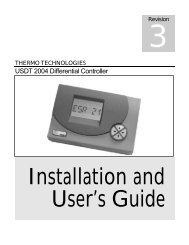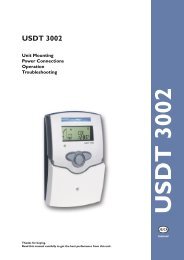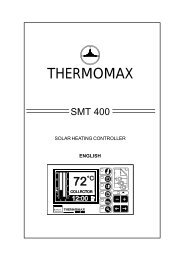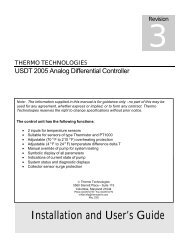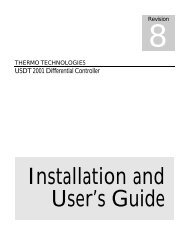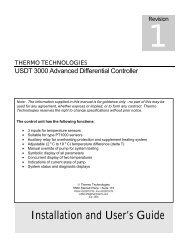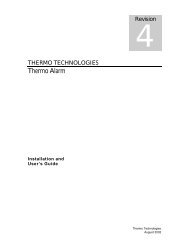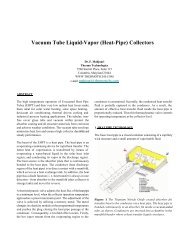The Relative Cost of Solar Thermal Collector Installation
The Relative Cost of Solar Thermal Collector Installation
The Relative Cost of Solar Thermal Collector Installation
Create successful ePaper yourself
Turn your PDF publications into a flip-book with our unique Google optimized e-Paper software.
unning, tubes are unpacked and inserted through a rubber<br />
grommet into manifold and secured into the compression<br />
clamp copper chamber in super insulated header.<br />
5. SUMMARY<br />
This paper identifies cost elements <strong>of</strong> direct solar water<br />
heating systems and simplicity <strong>of</strong> solar water heating<br />
installation on commercial buildings with a hot water<br />
circulation loop. <strong>The</strong>se systems rely on several key design<br />
features. <strong>The</strong> diode function <strong>of</strong> heat-pipe, the superior<br />
insulation <strong>of</strong> evacuated tube, and active digital controls for<br />
successful operation and protection from freezing and<br />
overheating are all essential elements. Project participants<br />
are pleased with the relative ease <strong>of</strong> implementing this type<br />
<strong>of</strong> system and its total costs.<br />
<strong>The</strong> cost analysis shows that 37% <strong>of</strong> total project costs are<br />
logistic expenses. Only 33% <strong>of</strong> total cost goes towards<br />
collector and system instrumentation with 14% for<br />
installation and 5 % for the balance <strong>of</strong> the system.<br />
6. ACKNOWLEDGEMENTS<br />
Figure 13: <strong>Installation</strong> costs are 14% <strong>of</strong> the total vacuum<br />
tube system costs.<br />
Final inspection is conducted after all tubes are inserted to<br />
the manifolds. At this stage, the controller will be switched<br />
to automatic operation.<br />
<strong>The</strong> modularity and installation simplicity <strong>of</strong> <strong>The</strong>rmomax<br />
tubes minimizes the installation costs. <strong>The</strong> most difficult<br />
and time-consuming part <strong>of</strong> an installation typically is<br />
positioning <strong>of</strong> ballast blocks.<br />
<strong>The</strong> authors would like to thank Robert Billak (retired) <strong>of</strong><br />
the Pentagon Energy Office, John Broughton and Curt<br />
Iffinger <strong>of</strong> the NASA Energy Management Office, Robert<br />
Stiteler <strong>of</strong> Midatlantic Social Security Center, Ethan Chon<br />
and Renee Domurat <strong>of</strong> the General Services Administration<br />
for procurement <strong>of</strong> the system. Further thanks go to Anne<br />
Crawley and Dr. Andy Walker <strong>of</strong> the US Department <strong>of</strong><br />
Energy, Federal Energy Management Program and for<br />
supporting NREL staff with the feasibility study,<br />
procurement specifications and design review.



